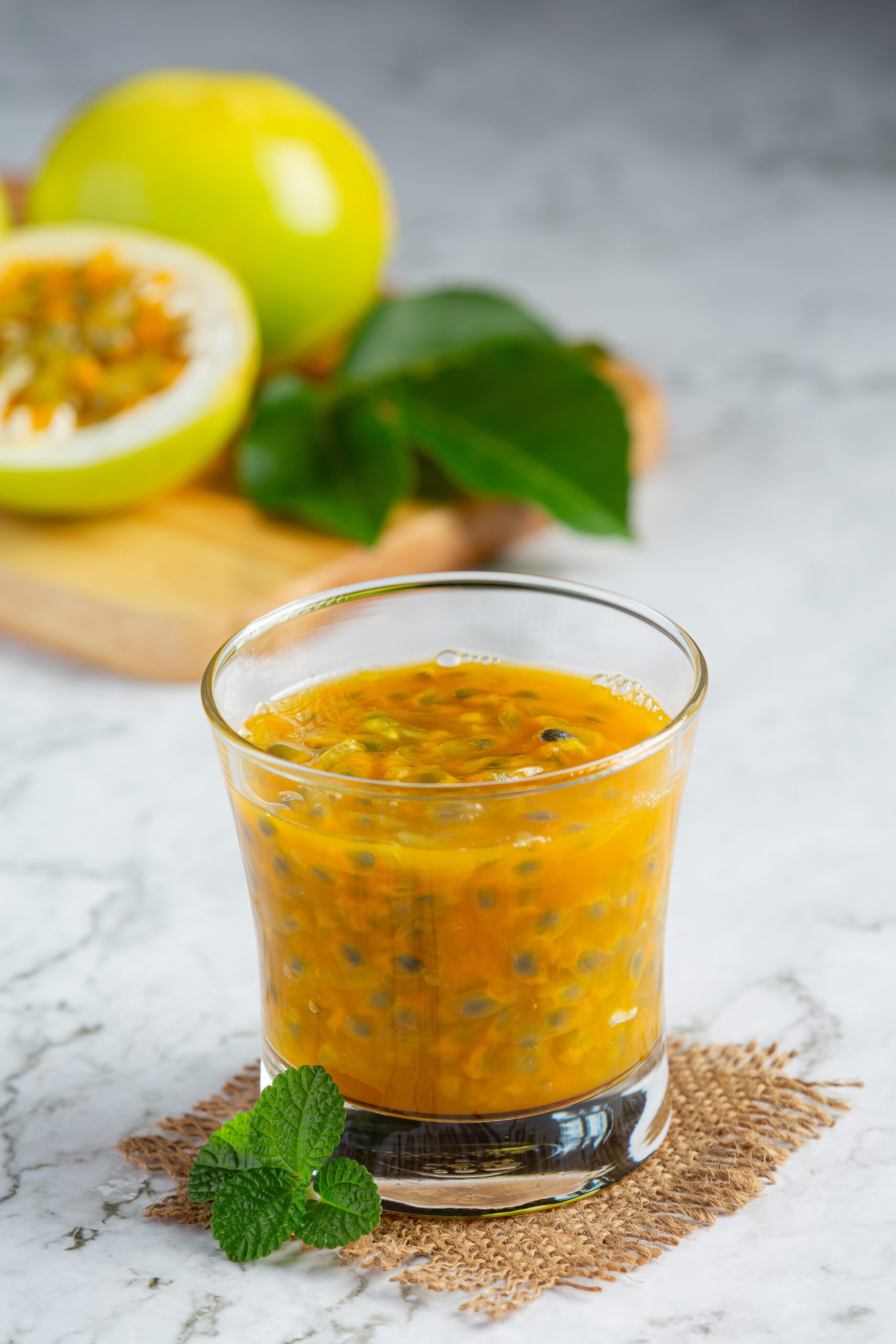Table of Contents
Introduction:
Welcome to the tropical world of passion fruit juice! This exotic and versatile beverage has gained popularity for its tantalizing flavors and numerous health benefits. In this article, we will delve into the vibrant world of passion fruit juice, exploring its nutritional value, unique flavors, and offering a variety of recipes to quench your thirst for something extraordinary.
Health Benefits of Passion Fruit Juice:
When it comes to health benefits, passion fruit juice is a true champion. Bursting with essential vitamins, minerals, and antioxidants, this tropical elixir can give your immune system a boost and promote overall well-being. Loaded with vitamin C, it helps strengthen your immune defenses and fights off pesky free radicals. Additionally, passion fruit juice contains a wealth of fiber, aiding digestion and promoting a healthy gut.

Flavors and Varieties of Passion Fruit Juice:
Prepare your taste buds for a flavor adventure! Passion fruit juice is renowned for its distinct taste, balancing sweet and tart notes in a perfect symphony. With different varieties available, you can choose between sweeter and more tangy options, allowing you to customize your juice experience. Don’t be surprised by the vibrant colors of passion fruit, as they can range from yellow to purple, each contributing its unique character to the juice.
How to Make Passion Fruit Juice:
Are you ready to embark on a homemade passion fruit juice journey? Fear not, as it’s surprisingly easy! To extract the juice, simply cut open a ripe passion fruit and scoop out the pulp. Strain the pulp to separate the juice from the seeds, or if you prefer a thicker texture, blend the pulp with a little water. Don’t forget to add a touch of sweetness if desired, using honey or a natural sweetener. Voila! You have a refreshing glass of homemade passion fruit juice ready to be savored.
Creative Uses of Passion Fruit Juice:
Passion fruit juice is not just a thirst-quencher; it’s a versatile ingredient that can add a tropical twist to a range of culinary creations. Enjoy it as a stand-alone beverage, sipping its tangy goodness on a sunny day. Or get creative and experiment with incorporating passion fruit juice into your favorite cocktails and mocktails, adding a tropical flair to your happy hour. Its vibrant flavor can also elevate desserts, sauces, and dressings, providing a delightful burst of tangy sweetness.
Popular Recipes with Passion Fruit Juice:
Now, let’s dive into some mouthwatering passion fruit juice recipes that will transport you to a tropical paradise. Try a classic passion fruit juice drink by combining the juice with a splash of lime and a hint of sugar. For a healthy and energizing option, whip up a passion fruit smoothie or smoothie bowl by blending the juice with yogurt, your choice of fruits, and a handful of ice. And if you’re feeling adventurous, indulge in a refreshing passion fruit cocktail, combining the juice with your preferred spirits and garnishing it with a slice of fresh fruit.
Buying and Storing Passion Fruit Juice:
While making your own passion fruit juice is an enticing option, you can also find packaged passion fruit juice in stores. When selecting fresh passion fruit, choose fruits that are slightly wrinkled and have a fragrant aroma, indicating ripeness. To prolong the shelf life of your passion fruit juice, store it in the refrigerator, ideally in a sealed glass container, for up to three days.
Countries of Origin:
Passion fruit, scientifically known as Passiflora edulis, is a tropical fruit that is believed to have originated in South America, specifically in the Amazon rainforest region of Brazil. The fruit has a long history and has been cultivated and enjoyed by indigenous tribes in the region for centuries. From its native roots, passion fruit spread to other parts of South America, including Paraguay and Argentina, and eventually made its way to other continents through colonization and trade.
Sourcing:
Today, passion fruit is grown and sourced from various regions around the world that have suitable climates for its cultivation. Some of the major sourcing countries include:
Brazil:
As the likely birthplace of passion fruit, Brazil remains a significant producer and exporter of the fruit. The country’s diverse climates and fertile soils support the cultivation of different passion fruit varieties, contributing to a steady supply in both domestic and international markets.
Ecuador:
Known for its high-quality passion fruit, Ecuador has emerged as a major player in the global passion fruit industry. The country’s favorable tropical climate and fertile volcanic soils provide ideal conditions for cultivating passion fruit, resulting in flavorful and aromatic fruits.
Vietnam:
Passion fruit cultivation in Vietnam has gained momentum in recent years. The country’s warm climate, ample rainfall, and suitable soil conditions allow for successful production. Vietnamese passion fruit is prized for its distinctive flavor and is exported to various parts of the world.
Colombia:
Passion fruit is also extensively cultivated in Colombia. The country’s diverse landscapes and favorable growing conditions enable the production of high-quality fruits, which are widely used in both domestic consumption and international markets.
Kenya:
In Africa, Kenya has become a notable passion fruit producer. The country’s equatorial climate and fertile soils in regions such as the Rift Valley create an ideal environment for passion fruit cultivation. Kenyan passion fruits are known for their tangy and aromatic qualities.
Other regions:
Passion fruit is also grown in other countries, including Australia, India, Israel, Peru, and the United States (particularly in Hawaii, California, and Florida). Each region offers unique characteristics to the fruit, resulting in subtle flavor variations.
Sourcing Methods:
Passion fruit can be sourced through various methods, including local farms, wholesalers, and international trade. In many sourcing regions, small-scale farmers play a significant role in passion fruit production. They cultivate the fruit on their farms and sell it to local markets or larger distributors who handle the export or distribution to other regions.
For international trade, passion fruit is often sourced by importers who establish relationships with reliable suppliers in the producing countries. These suppliers ensure the fruits are harvested at the optimal stage of ripeness, packed carefully to maintain their quality, and shipped to the desired destinations. Importers and distributors then make the fruits available to consumers through local grocery stores, markets, and other retail outlets.
In recent years, there has also been a rise in organic and sustainable passion fruit sourcing practices. Some farms adopt organic farming methods, avoiding synthetic pesticides and fertilizers. Additionally, fair trade initiatives aim to ensure fair compensation for farmers and promote environmentally friendly practices. Understanding the origin and sourcing of passion fruit allows consumers to make informed choices about the fruits they enjoy, supporting sustainable practices and appreciating the journey of this tropical delight from its roots in the Amazon to their own plate.

